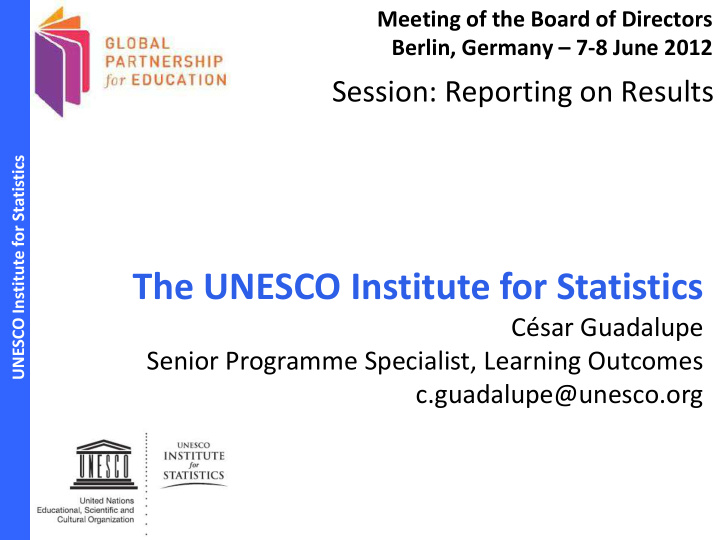



Meeting of the Board of Directors Berlin, Germany – 7-8 June 2012 Session: Reporting on Results UNESCO Institute for Statistics The UNESCO Institute for Statistics César Guadalupe Senior Programme Specialist, Learning Outcomes c.guadalupe@unesco.org
Outline Brief introduction to the work of the UIS Possible areas of interest for GPE: UNESCO Institute for Statistics Regional modules Education finance Learning outcomes 2
UNESCO Institute for Statistics Esta�lished �y UNESCO’s General Conferen�e in 1999 (autonomy: governing board, resources, recruitment) UNESCO Institute for Statistics Relocated to Université de Montréal in 2001 Currently has 125 staff 100 at HQ 25 in the field Funded by UNESCO and Doha New Delhi Bamak Bangkok Dakar o voluntary contributions Yaound Apia Nairob é i Dar-es- Apia Salaam Windho Santiago ek 3
The UIS as a data source UNESCO Institute for Statistics Results report 4
Improving relevance through a regional approach Responding to regional needs for policy- relevant indicators UNESCO Institute for Statistics Afri�an Union’s Se�ond De�ade for Edu�ation Regional Education Project for Latin America and the Caribbean (PRELAC) and CONFINTEA follow-up Building mechanisms to ensure that data are used regionally Providing data to regional databases and reports (e.g. ADEA and AU Observatory in Africa) Identifying regional means for disseminating results and fostering ownership 5
UIS regional approach: Africa Survey covers 45 sub- Saharan African UNESCO Institute for Statistics countries Launched in 2011 80% response rate Good country collaboration suggests that the regional education survey can help to meet data needs for programme design and policy development 6
UIS regional approach: Africa UNESCO Institute for Statistics 7
Average class size by grade in selected countries, 2010 or latest year available UNESCO Institute for Statistics 8
Textbooks: in most countries children must share textbooks UNESCO Institute for Statistics 9
Many schools have no toilet facilities UNESCO Institute for Statistics 10
Most schools have no electricity UNESCO Institute for Statistics 11
Finance data: innovative approaches Improved coverage of financial indicators by UIS Tools to align sector review data with the UIS database UNESCO Institute for Statistics Wider use of other sources, especially government official account books Improved institutional capacities to compile and report financial data on a regular basis Worked closely with country teams on national reports presenting analytic indicators on education finance 9 sub-Saharan African countries (Benin, Burkina Faso, Central African Republic, Gambia, Ghana, Malawi, Mali, Rwanda, Togo) 3 LAC countries (Ecuador, Guatemala and Nicaragua) 12
13 Public expenditure on education in sub-Saharan Africa: increased commitment In sub-Saharan Africa, education expenditure grew, on average, by 6% every year between 2000 and 2008 (in constant LCUs) Average annual growth rate UNESCO Institute for Statistics 13 Source: UNESCO Institute for Statistics, 2011
14 Allocating funds across education sectors: primary and secondary trade-offs The case of Burundi Increased total education budget from 3.2% to 8.3% of UNESCO Institute for Statistics GDP Shifted resource allocation to primary education School fee abolition in 2005 38% of budget (1999) to 53% (2009) Primary gross enrolment rate tripled since 1999 GER: 49% in 1999 – 147% in 2009 Out-of-school children number reduced But no growth in secondary
UNESCO Institute for Statistics Relative costs and access 15
Teacher salaries and country’s wealth UNESCO Institute for Statistics 16
Observatory of Learning Outcomes Measuring the quality of education presupposes having systematic information on learning levels. Compile existing information produced by national UNESCO Institute for Statistics and international assessments and examinations: A catalogue of existing assessments: approaches followed by countries. Provide technical documentation to: (i) better understand the existing body of information; (ii) better decisions on what/how to measure. Promote linkages among existing studies in order to generate a common body of comparable information: Regional assessments (PASEC, SACMEQ, LLECE) and IEA/PIRLS to explore options for convergence and 17 collaboration.
UNESCO Institute for Statistics 18
Final remarks International statistics are a public good Focus on institutional development: UNESCO Institute for Statistics working with country teams so knowledge development relies on existing capacities and reinforce them at country level (for instance: 9 African and 3 LA countries involve in education finance work) Transparency, independence and quality of work lead to trust . 19
For additional info, please contact: Hendrik van der Pol. UIS/Director (h.van-der-pol@unesco.org) UNESCO Institute for Statistics Albert Motivans. Head, Education Indicators and Data Analysis (a.motivans@unesco.org) César Guadalupe. Head, Learning Outcomes (c.guadalupe@unesco.org) http://www.uis.unesco.org Thank you 20
Recommend
More recommend